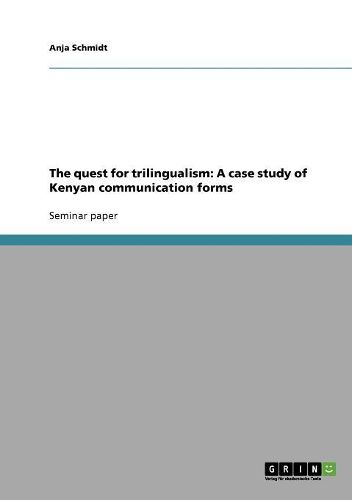Readings Newsletter
Become a Readings Member to make your shopping experience even easier.
Sign in or sign up for free!
You’re not far away from qualifying for FREE standard shipping within Australia
You’ve qualified for FREE standard shipping within Australia
The cart is loading…






Seminar paper from the year 2003 in the subject English Language and Literature Studies - Linguistics, grade: 1,0 (A), University of Hamburg (IAA), 16 entries in the bibliography, language: English, abstract: When considering the linguistic situation in Kenya, it becomes quite obvious that it is anything but homogenous. Not only the large variety of different ethnic groups, but also British colonial influences have left their marks on this diverse region. With English as the official language and Kiswahili as the national language, it seems that the language situation in Kenya should be clear cut and well defined. Yet, the search for a national identity, feelings of inferiority towards the colonial language English and the strive for a better political and economic life in Kenya confront the population with many challenges and problems. Kenyan society is shaped by 40 to 60 African ethnic languages, such as Maasai or Dholuo. The main means of communication among these different ethnic groups has become Kiswahili. But Kiswahili itself has seven dialects and several sub-dialects. In addition, several European languages were left behind by the colonial era and Arabic and Asian merchants have brought their languages with them too. Thus, the language situation in Kenya is extremely complex and considered to be a 3 + 1 language country. That means that most Kenyan citizens speak three languages (plus or minus one): the mother tongue (in most cases an African ethnic language), Kiswahili - the national language and most often also lingua franca, and English - the official language and therefore used for all educational and governmental purposes. But the competence and use of these communication systems varies largely. Like citizens of other imposed multilingual environment situations, Kenyans have developed their very own way to communicate with each other. But language is not only a pure means of communication - it carries different identities depending on social contex
$9.00 standard shipping within Australia
FREE standard shipping within Australia for orders over $100.00
Express & International shipping calculated at checkout
Seminar paper from the year 2003 in the subject English Language and Literature Studies - Linguistics, grade: 1,0 (A), University of Hamburg (IAA), 16 entries in the bibliography, language: English, abstract: When considering the linguistic situation in Kenya, it becomes quite obvious that it is anything but homogenous. Not only the large variety of different ethnic groups, but also British colonial influences have left their marks on this diverse region. With English as the official language and Kiswahili as the national language, it seems that the language situation in Kenya should be clear cut and well defined. Yet, the search for a national identity, feelings of inferiority towards the colonial language English and the strive for a better political and economic life in Kenya confront the population with many challenges and problems. Kenyan society is shaped by 40 to 60 African ethnic languages, such as Maasai or Dholuo. The main means of communication among these different ethnic groups has become Kiswahili. But Kiswahili itself has seven dialects and several sub-dialects. In addition, several European languages were left behind by the colonial era and Arabic and Asian merchants have brought their languages with them too. Thus, the language situation in Kenya is extremely complex and considered to be a 3 + 1 language country. That means that most Kenyan citizens speak three languages (plus or minus one): the mother tongue (in most cases an African ethnic language), Kiswahili - the national language and most often also lingua franca, and English - the official language and therefore used for all educational and governmental purposes. But the competence and use of these communication systems varies largely. Like citizens of other imposed multilingual environment situations, Kenyans have developed their very own way to communicate with each other. But language is not only a pure means of communication - it carries different identities depending on social contex